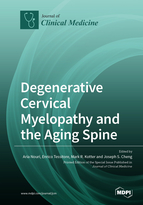Degenerative Cervical Myelopathy and the Aging Spine
A special issue of Journal of Clinical Medicine (ISSN 2077-0383). This special issue belongs to the section "Orthopedics".
Deadline for manuscript submissions: closed (1 February 2020) | Viewed by 46528
Special Issue Editors
Interests: Degenerative Cervical Myelopathy (DCM); Magnetic Resonance Imaging (MRI); cervical canal stenosis; Subacute Combined Degeneration of the Spinal Cord (SACD); anemia and DCM; cervical spine surgery; surgical decision-making; surgical outcome prediction; Ossification of the Posterior Longitudinal Ligament (OPLL); cervical spondylolithesis
Special Issues, Collections and Topics in MDPI journals
Interests: degenerative cervical myelopathy; the aging spine
Special Issues, Collections and Topics in MDPI journals
Interests: cervical myelopathy; spinal cord injury; stem cells; cellular reprogramming
Special Issue Information
Dear Colleagues,
As many of you already know, Degenerative Cervical Myelopathy (DCM) is the most common cause of spinal cord impairment in the developed world, leading not only to a decrease in the quality of life of those affected but also to a growing healthcare burden. Over the past few years, a number of multicentre studies on the topic have emerged, helping to provide a better understanding of the condition. However, it is also clear that much remains to be learned. This is evidenced by the fact that the term DCM was only formally introduced in 2015, guidelines on DCM based on the GRADE (Grading of Recommendations Assessment, Development and Evaluation) process were published in 2017, and, at the present time, an active effort called RECODE-DCM (Research Objectives and Common Data Elements for Degenerative Cervical Myelopathy) is underway that aims to shape the way future DCM research is carried out. With this Special Issue, we hope to encourage submissions that discuss the current state-of-the-art, address ongoing knowledge gaps, and focus on ongoing controversies related to Degenerative Cervical Myelopathy and the management of the aging spine.
We look forward to receiving your submission.
Dr. Aria Nouri
Dr. Enrico Tessitore
Dr. Mark R. Kotter
Dr. Joseph Cheng
Guest Editors
Manuscript Submission Information
Manuscripts should be submitted online at www.mdpi.com by registering and logging in to this website. Once you are registered, click here to go to the submission form. Manuscripts can be submitted until the deadline. All submissions that pass pre-check are peer-reviewed. Accepted papers will be published continuously in the journal (as soon as accepted) and will be listed together on the special issue website. Research articles, review articles as well as short communications are invited. For planned papers, a title and short abstract (about 100 words) can be sent to the Editorial Office for announcement on this website.
Submitted manuscripts should not have been published previously, nor be under consideration for publication elsewhere (except conference proceedings papers). All manuscripts are thoroughly refereed through a single-blind peer-review process. A guide for authors and other relevant information for submission of manuscripts is available on the Instructions for Authors page. Journal of Clinical Medicine is an international peer-reviewed open access semimonthly journal published by MDPI.
Please visit the Instructions for Authors page before submitting a manuscript. The Article Processing Charge (APC) for publication in this open access journal is 2600 CHF (Swiss Francs). Submitted papers should be well formatted and use good English. Authors may use MDPI's English editing service prior to publication or during author revisions.
Keywords
- Degenerative cervical myelopathy (DCM)
- Imaging of the cervical spine
- Cervical canal stenosis
- Cervical spine surgery
- Surgical outcome prediction
- Ossification of the posterior longitudinal ligament (OPLL)
- Cervical spondylolisthesis
- Cervical deformity
- Spinal cord compression








